Quando abbiamo iniziato a usare Google AMP nel 2016, sembrava il futuro del web mobile. Ma nel corso degli anni abbiamo aiutato centinaia di proprietari di siti web ad abbandonare AMP a causa dei suoi limiti e della mutata posizione di Google sull’indicizzazione mobile-first.
Come molti utenti di WordPress, potreste chiedervi se sia giunto il momento di disabilitare AMP sul vostro sito. Con Google che non richiede più AMP per le posizioni di ricerca in alto e con l’aumento delle funzioni vitali del web, i nostri lettori ci pongono regolarmente domande sulla rimozione di AMP.
Abbiamo testato diversi metodi per disabilitare correttamente AMP in diverse configurazioni di WordPress. Condivideremo gli approcci più affidabili che non danneggeranno la vostra SEO o le prestazioni dei dispositivi mobili.
Sia che si utilizzi il plugin AMP ufficiale o un tema con supporto AMP integrato, vi mostreremo esattamente come effettuare questa transizione senza problemi.
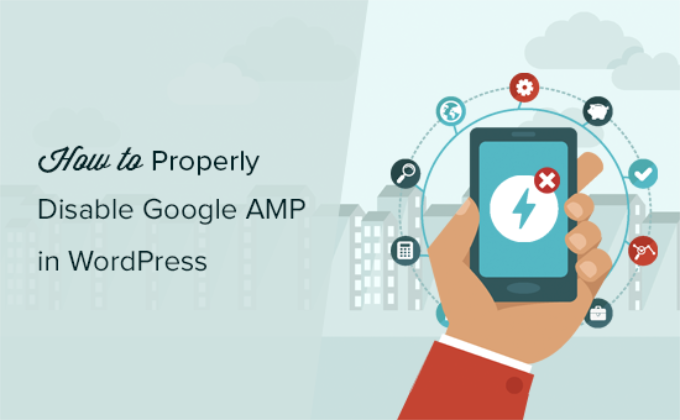
Perché si dovrebbe disabilitare Google AMP in WordPress
Accelerated Mobile Pages (AMP) è un’iniziativa open-source per rendere il web più veloce per gli utenti mobili e migliorare l’esperienza dell’utente.
Lo fa servendo pagine con HTML e JavaScript ridotti al minimo. Ciò consente al contenuto di essere ospitato nella cache di Google AMP. Google può quindi servire questa versione memorizzata nella cache agli utenti quando fanno clic sul vostro link nei risultati di ricerca.
Tuttavia, se avete scelto di impostare Google AMP in WordPress, potreste pensare di aver fatto la scelta sbagliata.
Non siete soli. Molti blogger, influencer e pubblicazioni online hanno smesso di usare AMP sui loro siti web WordPress.
In primo luogo, esamineremo i motivi per cui potreste prendere in considerazione la disattivazione di AMP sul vostro sito web WordPress e poi vi illustreremo la procedura da seguire.
Google Analytics 4 non supporta AMP
Google Analytics 4 o GA4 è l’ultima versione di Google Analytics che tiene traccia del vostro sito web e delle applicazioni mobili nello stesso account. Apporta numerosi cambiamenti, tra cui nuovi metodi di tracciamento, funzioni di reporting, metriche e rapporti.
Tra questi cambiamenti c’è il fatto che GA4 non supporta ufficialmente AMP al momento e non è confermato se funzionerà in futuro. Uno dei motivi è che tiene traccia dei visitatori del sito web e dell’app nella stessa proprietà.
Tuttavia, Google ha dichiarato che sarà possibile accedere ai vecchi dati nella proprietà Universal Analytics solo fino al 1° luglio 2024. Ciò significa che è ancora possibile accedere ai report di Universal Analytics per visualizzare i dati passati, ma non sarà ancora possibile tracciarli nell’ultima versione.
Drastico calo dei tassi di conversione
Google AMP impone molte restrizioni su HTML/JavaScript. Ciò significa che molti elementi interattivi del vostro sito web WordPress vengono a mancare con AMP, come i moduli optin e i popup di uscita.
Di conseguenza, i proprietari dei siti non possono incoraggiare gli utenti a iscriversi, a compilare i moduli di contatto o ad acquistare prodotti.
Minori visualizzazioni di pagine da parte degli utenti mobili
AMP non mostra le barre laterali del sito o altre funzioni di scoperta dei contenuti. Ciò provoca un calo significativo delle pagine viste dagli utenti mobili.
In effetti, alcuni esperti di esperienza utente suggeriscono che il pulsante di chiusura in alto incoraggia gli utenti a tornare alla ricerca di Google dopo aver letto il vostro articolo, invece di navigare nel vostro sito web.

Minore coinvolgimento degli utenti
Molti siti web si basano sulle interazioni con gli utenti, come i widget click-to-tweet, le valutazioni degli utenti, i commenti e così via. Google AMP rende piuttosto difficile per i proprietari di siti web mantenere gli utenti impegnati e interagire con i loro contenuti.
Dovreste disattivare Google AMP?
La risposta a questa domanda dipende dal vostro sito web. Se gli utenti mobili costituiscono la maggior parte del vostro pubblico, potreste comunque voler utilizzare AMP.
D’altra parte, se avete provato Google AMP e ha influito negativamente sui vostri tassi di conversione, probabilmente dovreste disabilitare Google AMP sul vostro sito web.
Contrariamente a quanto si crede, Google non penalizza i siti web che non utilizzano AMP. Potete comunque migliorare la velocità e le prestazioni del vostro sito web su mobile per competere con il pubblico della ricerca mobile.
Tenendo presente tutto ciò, vediamo come disabilitare AMP sul vostro sito WordPress.
Disabilitare i plugin di Google AMP in WordPress
Non tutti utilizzano gli stessi plugin di WordPress per aggiungere il supporto AMP ai propri siti web. Tuttavia, le impostazioni di base rimangono le stesse indipendentemente dal plugin utilizzato.
La prima cosa da fare è disattivare il plugin AMP installato.
È sufficiente visitare la pagina Plugin ” Plugin installati dalla dashboard di WordPress e fare clic su “Disattiva” sotto il nome del plugin AMP.
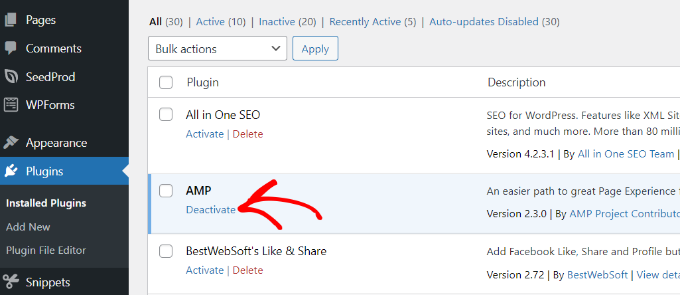
La semplice disattivazione del plugin disabilita il supporto AMP sul vostro sito web. Tuttavia, ci sono altri passaggi da seguire per garantire che il vostro sito sia privo di AMP.
Impostazione dei reindirizzamenti per le pagine AMP
La disattivazione del plugin AMP rimuove la versione AMP degli articoli dal sito web. Tuttavia, questo da solo non è sufficiente, soprattutto se AMP è attivo da più di una settimana.
È molto probabile che Google abbia già indicizzato quelle pagine e continui a mostrarle nei risultati di ricerca. Se un utente fa clic su una di esse e voi l’avete rimossa dal vostro sito, troverà una pagina 404, poiché quel contenuto è ormai scomparso.
Per risolvere questo problema, è necessario reindirizzare gli utenti che arrivano alle pagine AMP alle normali pagine non AMP.
Vi mostreremo due metodi diversi per impostare i reindirizzamenti per Google AMP, prima usando un plugin e poi usando il codice. Potete scegliere quello più conveniente per voi.
Metodo 1: Utilizzo di un plugin di reindirizzamento
Il modo più semplice per impostare la reindirizzazione in WordPress è utilizzare il plugin All in One SEO (AIOSEO). È il miglior plugin SEO per WordPress che offre un potente gestore di reindirizzamenti.
È necessario disporre della licenza AIOSEO Pro, che include il gestore di reindirizzamento.
Innanzitutto, è necessario installare e attivare il plugin All in One SEO (AIOSEO). Per maggiori dettagli, consultate la nostra guida passo passo su come installare un plugin di WordPress.
Dopo l’attivazione, potete andare su All in One SEO ” Reindirizzamenti dalla dashboard di WordPress e fare clic sul pulsante “Attiva reindirizzamenti”.
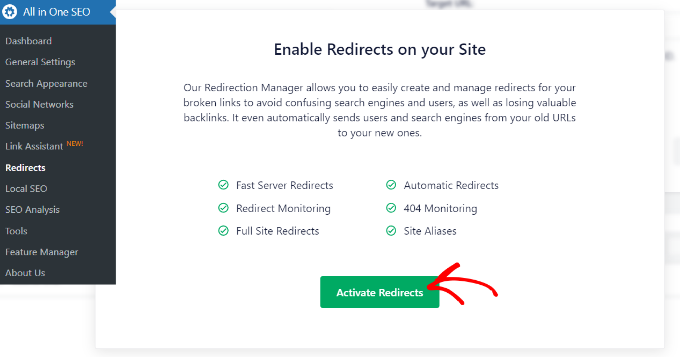
Questo vi aiuterà a installare il componente aggiuntivo AIOSEO Redirection Manager che gestisce questa funzione. Dopo l’attivazione, si accede alla scheda “Reindirizzamenti”. Qui è possibile inserire gli URL di origine e di destinazione per impostare il reindirizzamento.
Per prima cosa, è necessario fare clic sull’icona “ingranaggio” nel campo URL sorgente e poi attivare la casella di controllo “Regex”.
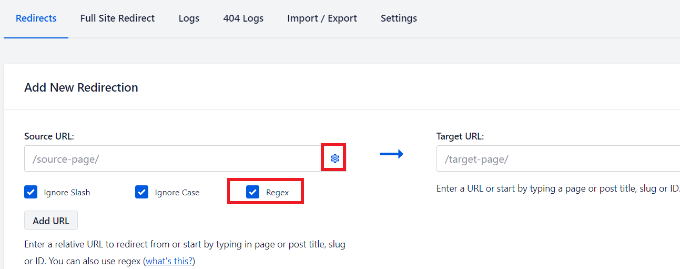
Successivamente, è possibile aggiungere il seguente codice nel campo URL sorgente:
1 | ^/(.*)\/amp |
Nel campo URL di destinazione, è necessario aggiungere l’URL del sito web nel formato seguente:
1 | https://example.com/$1 |
Non dimenticate di sostituire “example.com” con il vostro nome di dominio.
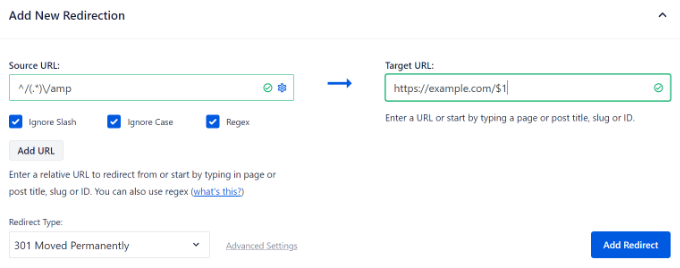
Successivamente, è possibile mantenere il “Tipo di reindirizzamento” come 301 spostato in modo permanente. In questo modo, gli utenti saranno reindirizzati in modo permanente alle pagine nonAMP.
Infine, fare clic sul pulsante “Aggiungi reindirizzamento” per salvare le modifiche.
È ora possibile visitare l’URL di una precedente pagina AMP del proprio sito web per verificare se il reindirizzamento funziona correttamente.
AIOSEO vi aiuta anche a tenere traccia dei link interrotti sul vostro sito web. È possibile identificare rapidamente le pagine AMP che causano errori 404 e reindirizzarle. Per maggiori dettagli, consultate la nostra guida su come monitorare le pagine 404 e reindirizzarle in WordPress.
Metodo 2: Impostare manualmente i reindirizzamenti in .htaccess
Se non volete usare un plugin per impostare i reindirizzamenti, potete configurare il reindirizzamento usando il file .htaccess sul vostro account di hosting WordPress.
Per prima cosa, dovrete collegarvi al vostro sito web utilizzando un client FTP o il File Manager di cPanel. Per maggiori dettagli, consultate la nostra guida su come usare FTP per caricare file in WordPress.
Una volta collegati, è necessario individuare il file .htaccess nella cartella principale del sito web.

Successivamente, è possibile modificare il file nella cartella principale.
Aggiungete quindi il seguente codice in fondo al vostro file .htaccess:
1 2 3 4 | // Redirect AMP to non-AMPRewriteEngine OnRewriteCond %{REQUEST_URI} (.+)/amp(.*)$RewriteRule ^ %1/ [R=301,L] |
Non dimenticate di salvare le modifiche e di caricare il file sul vostro server.
È ora possibile visitare l’URL della precedente versione AMP di qualsiasi post sul proprio sito web per verificare che il reindirizzamento funzioni come previsto.
Speriamo che questo articolo vi abbia aiutato a disabilitare correttamente Google AMP in WordPress. Potreste anche voler consultare la nostra guida definitiva alla SEO di WordPress passo dopo passo per i principianti e i migliori consigli per velocizzare WordPress.
Se questo articolo vi è piaciuto, iscrivetevi al nostro canale YouTube per le esercitazioni video su WordPress. Potete trovarci anche su Twitter e Facebook.





Sarah
Hi,
Tried adding :
// Redirect AMP to non-AMP
RewriteEngine Aan
RewriteCond %{REQUEST_URI} (.+)/amp(.*)$
RewriteRule ^ %1/ [R=301,L]
But still lots of 404’s looking for AMP?
WPBeginner Support
We would recommend checking with your hosting provider as some have settings that need to be applied for redirects to work.
Admin
Ravi Bandakkanavar
Thanks for the redirection trick. It worked like a rocket
WPBeginner Support
Glad our guide could help!
Admin
Vyom Manikya
After following all the steps, now I’m getting this error “Discovered – Currently not Indexed” for my non-amp pages.
Loren
I’ve tried applying this to a site I’m working on without any luck. I’ve cleared cache and tried a handful of other things, but the redirects do not seem to be catching. Does this work for sites that google is wrapping the url in themselves?
Scott Hunt
I installed the Redirection Plugin and followed the process. Amp was only Active on our mobile version and only showed if our website was searched, for example, Delta, and then clicked on the link. If you entered the URL in the address bar it would show our website correctly. I am at a loss!
I know it was amp because Amp is the in URL when the website is not displayed correctly. Any advice would be sincerely appreciated.
WPBeginner Support
You would want to ensure you clear any caching you have on your site as that could be showing the cached version of the page on your site instead of the updated version.
Admin
James
Hey WPbeginner, Great article and helped me so much with my website .
Thanks
WPBeginner Support
Glad our guide was helpful
Admin
GILL COTTER
I did it and it works thanks.. I was in a panic. Just one thing – a little sad looking emoji guy pops up and says ‘404 that’s an error’ just before the user is directed to the correct page. It pops up for a minute then goes away. How can I get rid of him?
WPBeginner Support
You may either need to clear your browser cache or check with your hosting provider to ensure there isn’t something causing issues with your redirects.
Admin
Hicham
It works, Thanks so much ☺
WPBeginner Support
Glad our guide was helpful
Admin
Akshay Malhotra
Thank you so much for this post. As always WP beginner rocks!
WPBeginner Support
Glad you found our content helpful
Admin
sai ram
I have removed AMP from my website but when disabled my AMP i will recieved new issue in Google Search Console as a “Referenced AMP url is not an AMP”.
Please tell me sir how can it solved.
WPBeginner Support
You would want to set up redirection following step 2 for fixing that issue.
Admin
Mustafa
That’s great info and help guys. Thanks a lot. Here’s my question:
What is the right direction code or way for redirect my old website’s amp pages to my new domain’s non-amp pages?
WPBeginner Support
You would want to follow step 2 in the article and have the source URL be the old domain before the / in our recommendation.
Admin
Daniel
Can I delete the Redirect plugin when all the amp pages are deindexed from Google?
WPBeginner Support
We would recommend keeping the plugin active while using the redirect if you use the plugin method.
Admin
Faiz Khan
Today I desabled AMP plugin. When I checked my website with AMP URL it showing error.
WPBeginner Support
That issue is solved with the redirects which we show in this article
Admin
Stephen Walker
Hit a little snag. I have added the code you suggest to my .htaccess file. I now get an internal error 500 from the server if I am trying to access an amp post. Normal pages display correctly.
WPBeginner Support
For the 500 error, we would recommend first going through our guide below for possible solutions:
https://www.wpbeginner.com/wp-tutorials/how-to-fix-the-internal-server-error-in-wordpress/
Admin
Alvine
Thanks for the wonderful article. I wonder how one can remove just a single page from amp. Your method only explains removing all amp pages of a website but I want to remove just one page. How can I remove it please help.
WPBeginner Support
You would want to check with the plugin’s support for if that is currently an option. Normally, you should see an option on the page/post itself to not use AMP.
Admin
Laura
This is super easy to follow, so I’m so grateful to have found this post – but my AMP pages are still showing on Google, even after doing the redirection using the Redirection plugin. I’m not sure what to do, I saw in the comments something about caching, but I’m not sure how to do this?
WPBeginner Support
For Google’s cache, you would need to have Google recrawl your site with its URL checker or wait for Google to notice the update and change your links.
Admin
Adeel Qadir
Thanks for such a nice article and your way of explaining was very simple. With this helpful article, I have easily redirected my website and remove AMP successfully.
Lots of thanks
WPBeginner Support
You’re welcome, glad our guide was helpful
Admin
Parkashjit Singh
Hi Sir, i following all the steps but, i saw all the amp link on google which are ranked now how i can removed that amp ranked links on google. As well when i search on google about my site then i saw amp logo after my site tittle even now I’m not using apm. Now how i removed that icon.
WPBeginner Support
You would need to have Google recrawl your site to start removing the content from Google’s search results.
Admin
Parkashjit Singh
How, is there any tutorial or bog. Please send me
WPBeginner Support
You can find our article on how to do this below:
https://www.wpbeginner.com/wp-tutorials/how-to-ask-google-to-recrawl-urls-of-your-wordpress-site/
Raj Deep
My site uses ssl and is on https. Should I use https or http in the redirection ?
WPBeginner Support
Use HTTPS
Admin
Robin
Hey I have page which have /?amp AMP format. So what change I have to do for proper redirection,
As the code given above /(.*)\/amp is only redirection pages with /amp.
Please tell me what change required for this ? thing.
WPBeginner Support
You could create an additional redirect where you add * before amp if you customized your amp URLs to show like that.
Admin
Bob Morris
Thanks. I found this article after one too many posts with 17 indecipherable AMP errors
WPBeginner Support
Glad our guide could be helpful
Admin
Farblos Kay
This is the best website to learn and fix anything WordPress. You guys are geniuses!
WPBeginner Support
Thank you, glad you find our content helpful
Admin
Subodh Gupta
I have disabled AMP on my site using the mentioned codes. But the post/page previews are showing in AMP mode. What to do? Using TagDiv NewsPaper theme.
WPBeginner Support
You would want to ensure you’ve cleared all of your caching for the most common reason for that.
Admin
Adnan
Yours AMP pages are in Google cache, so when Google Bot re-index and check no rel=”amphtml” tag they index non-AMP page.
Julia
Hi, this article sounds very useful, thanks for sharing!
Before I will deactivate/uninstall AMP plugin as well, I have to ask a question.
I have, by mistake, redirected few of amp links (with amp plugin already installed) to my normal url link:
example.com/amp to example.com
The reason why I did that redirect with redirection plugin, is that I had no knowledge of what amp is, and so I thought it’s an error, when I was migrating my site.
Now my question is, should I rather disable all my redirects with amp and then disable/uninstall the AMP plugin and then do the bulk redirect ?
Thank you for your help!
WPBeginner Support
To be safe you may want to create an export of your current redirects, remove them, then do the method in this article to prevent the possibility of multiple redirects
Admin
Pratik Bhatt
Hi,
Can you tell me, when we can remove the redirection plugin. Does google remove the amp pages automatically after some time?
WPBeginner Support
Once the amp pages are no longer being indexed you can remove the redirection. It takes time and Google recrawling your site for the links to be removed.
Admin
Pratik Bhatt
Thanks for the quicky reply.
One more question, I’ve to ask, If I don’t do the redirection, then still google remove the amp pages after some time?
Thanks.
WPBeginner Support
Eventually yes
sam
Hi
I followed the steps above. However, when searching on my mobile device the amp pages are still popping up (It’s only been a few hours so this may be why). When I search on desktop device and type in domain.com/amp the redirect works perfectly. Do you know why this is happening?
WPBeginner Support
You would need to clear any caching as the most common reason it would still be showing up.
Admin
Kuldeep Singh
Worked like a charm.
Thanks!
WPBeginner Support
Glad our guide was helpful
Admin
Jason
Great Guide! Worked like a charm.
WPBeginner Support
Thank you, glad our guide was helpful
Admin
ahs shaikh
thank you very much for this blog post…
WPBeginner Support
You’re welcome
Admin
Rahul sarawagi
Hey,
I tried this way and now my website is not loading, it is giving an error message that
” redirected you too many times ”
Please help me out in getting it back.
WPBeginner Support
For the too many redirects error, you would want to take a look at our guide here: https://www.wpbeginner.com/wp-tutorials/how-to-fix-error-too-many-redirects-issue-in-wordpress/
Admin
Dietrich
I have done method 1 and cleared/deleted cache and it still shows the AMP version? Any tips how to fix?
WPBeginner Support
You would want to check that your host does not have caching enabled and your redirects do no have any typos
Admin
Rohit verma
i have done the first method but it still shows amp version what to do?
WPBeginner Support
You would want to clear any caching as the most likely cause
Admin
Subham
Hi,
You guys are doing great.
After creating AMP i have seen down in my traffic.
So i decided to remove that and i did.
I got many errors. So, i had to install amp again.
Now finally this article helped me a lot to completely remove amp.
Thank you very much WPbeginner.
You are a lifesaver!
WPBeginner Support
Glad our guide could be helpful
Admin
Catherine Thomas
THANK YOU!!!! Method #1 worked perfectly!!!
WPBeginner Support
Glad our recommendations could help
Admin
Akash Gogoi
Can I disable redirection plugin after AMP completely gone from Google search result? Please help.
WPBeginner Support
If you would like you can. Be warned that would remove the redirects so if the links start appearing as broken links in your search console you may need to readd the redirects.
Admin
Enes
Hey. Thank you very much for the info but i had a question. It does not work with me method 1. it suppose to be non amp as soon as i do redirect right ?
my website is https so i made it as https that what it should be ? Thanks in advance
WPBeginner Support
If you are using https then you would want the second field as https, as long as you don’t have caching then it should automatically update. If not, you would want to reach out to the plugin’s support for them to take a look.
Admin
Suanlian Tangpua
When should I remove the redirection?
WPBeginner Support
As it would depend on if Google still links to your AMP pages, we don’t have a set time to remove it we would recommend at the moment.
Admin
Hiral
Hi, thanks for helping. I used method 1. All the blog posts are being displayed in proper format but home page, about, contact such pages are still being displayed in AMP. How to fix it?
WPBeginner Support
You may want to check with the author of the redirection plugin to ensure there isn’t a hiccup with the created redirect.
Admin
Elsaid
Thanks a lot
Now I disable and delete AMP Plugin. and redirect lINKS by first method.
but I have a question , If I want reinstall AMP plugin again
what I should do about redirections????
WPBeginner Support
You would need to remove the redirections.
Admin
Kumarpal Shah
I’ve used Method 1 – Using Redirection Plugin. Now, my question is after adding the redirection is it necessary to keep plugin installed & activated?
OR I can remove the plugin after adding the redirection?
WPBeginner Support
Using the plugin, you would need to keep the plugin active for the redirects to continue.
Admin
Mario
It worked for me wpbeginner thanks a lot
Amp is not advisable use
WPBeginner Support
Glad our article could help
Admin
foodstyling
Hi,
I used the redirection method and the AMP pages are redirected to fine, but the address remain as /?amp.
Should I worry?
WPBeginner Support
If the redirection is working correctly, then you do not need to worry about the urls.
Admin
Mark Llego
I would like to know how can I 301 redirect if my amp url is structured like this
site.com/amp/your-article/
I am using better amp.
Thank you.
WPBeginner Support
Hi Mark,
The htaccess method in this post should handle that redirect for you
Admin
Joanna
Thank you so much! I was struggling with accidentally adding AMP pages and then removing them to losing a lot of traffic. Then, I felt defeated, so I reinstalled AMP. Method 1 with the Redirection plug-in was so easy I wish I had seen this sooner. THANKS!!
WPBeginner Support
Glad our article could help
Admin
Rajesh Ranjan
hii, i followed each and every step but its not working on my WordPress website.
WPBeginner Support
If you removed AMP completely and clearing your cache did not remove the AMP versions you may want to check with your hosting provider to ensure they don’t have caching or similar that would be affecting the AMP pages.
Admin
Margaret
I’m using the Yoast plugin for redirects – what do I input and where to redirect my amp urls to my non-amp ones?
Manh Nguyen
I do as instructed, how long does my site return to normal ?
Thanks!
katie larking
Hi I disabled the AMP plugin and set up a redirect as per the article. The redirect works, but the AMP pages are still in google index and working. How long until google replaces them with my non amp pages. Please let me know how long it takes organically vs anything I can do to speed this up that is proven to work. Thankyou!
Aaron Hunter
This helped so much thank you! I’ve asked WP support, and they had nothing to offer me for a solution. The new version of WordPress.com doesn’t let you deactivate AMP so I used the Redirection plugin. Thank you again!!!
Keith Whitworth
You are an absolute lifesaver! After implementing AMP, my user engagement dropped significantly, my site links in Google totally disappeared, my ranking (for my niche) was at the bottom of the barrel.
AMP is not really designed for podcasts AT ALL.
Once I decided it wasn’t going to work out, I deleted the plugin only to generate thousands of 404 errors related to AMP. I found myself creating unnecessary laborious work creating redirects every day as they popped up.
Finally, I got frustrated and performed a search and replace in my database to remove amp/ which was a massive mistake. Suddenly my site was no longer available. I deleted the plugin and everything was restored but what to do about all the 404 errors related to AMP?
I ran across your website through a Google search and presto. In one fell swoop, all my headaches disappeared. My sitelinks have been restored and yesterday I received an email from Google stating that mobile-first indexing was enabled on my site.
I cannot thank you enough!
WPBeginner Support
Hi Keith,
We are glad you found the article helpful You may want to join us on Twitter for more WordPress tips and tutorials. Next time you come across an issue, don’t forget to search WPBeginner first for a solution
You may want to join us on Twitter for more WordPress tips and tutorials. Next time you come across an issue, don’t forget to search WPBeginner first for a solution 
Admin